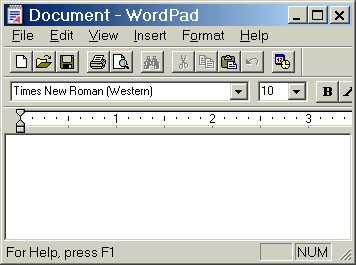Previous Page |
Page 2 |
 Next Page |
| ||
Previous Page |
Page 2 |
 Next Page |
| ||
Notepad

Notepad is a very simple, very basic word processing application (also known as a text editor). If you don't know how to use a fancy text editor such as Microsoft Word, you can still type, save and print simple documents using Notepad, a Windows Accessory.
You can change the font style and size in Notepad, but there are really no other features (although in some versions of Notepad you can automatically insert the time and date). You cannot format the text (center it on the page, for example), insert pictures, change the color of the text, etc. However, if you just want to type something simple and don't have or know how to use another text editor, Notepad is easy to use.
Documents created and saved in Notepad are saved as Text documents (with the ".txt" file name extension). Text documents can be opened by all word processing programs/text editors (such as Microsoft Word).
If you have questions about how to use Notepad, use the Help feature available in the application.
Practice:
Read all instructions before starting.
| 1. | Resize this lesson window and move it to the top of the screen. |
| 2. | Open the Start Menu, go to the Programs submenu and then the Accessories submenu, and select Notepad. If necessary, resize the Notepad window and move it around on the screen so that you can read these instructions. |
| 3. | Open each of the menus and look at the selections available. |
| 4. | Type your name in the document window. |
| 5. | Click on the Close ("X") button in the upper right-hand corner of the Notepad window to close it. |
| 6. | When the dialog box appears asking if you want to save the changes, click on the No button. |
| 7. | Click on this lesson window to return to it and then click on the Maximize button to return the window to its full screen size. |
NOTE: More practice with Notepad is available in the "Learning the Computer - Beginning" lesson on Text Editors.
WordPad

WordPad is another Windows Accessory and it is also a text editor, although it has many more features than Notepad. In addition to changing the font style and size and automatically inserting the date and time, you can format the text (e.g., center it), use bold, underline, and italics, insert pictures, change the text color, and use bullets with lists. WordPad also has toolbars and a ruler to make the application easier to use.
Again, if you need to type a document and don't know how to use another text editor such as Microsoft Word (or don't have another text editor available to use), WordPad is a Windows Accessory available on all versions of Windows. Learn how to use WordPad and you will be able to use it on any computer with Windows!
If you have questions about how to use WordPad, you can always use the application's Help feature.
Practice:
Read all instructions before starting.
| 1. | Resize this lesson window and move it to the top of the screen. |
| 2. | Open the Start Menu, go to the Programs submenu and then the Accessories submenu, and select WordPad. If necessary, resize the WordPad window and move it around on the screen so that you can read these instructions. |
| 3. | Open each of the menus and look at the selections available. |
| 4. | If the Format toolbar is showing, click on one of the buttons that has a "B" (bold), "I" (italics) or "U" (underline) on it. If the toolbar is not showing, go to the next step. |
| 5. | Type your name in the document window. |
| 6. | Click on the Close ("X") button in the upper right-hand corner of the WordPad window to close it. |
| 7. | When the dialog box appears asking if you want to save the changes, click on the No button. |
| 8. | Click on this lesson window to return to it and then click on the Maximize button to return the window to its full screen size. |
NOTE: More practice with WordPad is available in the "Learning the Computer - Beginning" lesson on Text Editors.
 Previous Page |
Next Page |